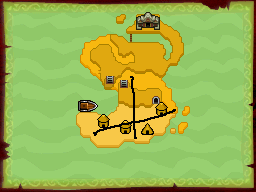

Stuck in a three-day loop in a doomed parallel world threatened by a grimacing and increasingly proximate moon, Link is stripped of his identity as the Hero of Time and left to reckon with mortality and loneliness. Made in just a year and using the same artistic and technological tools, Ocarina of Time’s weirder, even sadder little sibling is deeply atmospheric. Exploring these two Hyrules – the one of Link’s childhood and the one of his nightmares – I’m struck not just by how enjoyable the game is, how confidently the designers wielded these entirely new 3D tools, but also by how elegantly it evokes childhood fears and loss of innocence. There’s little Link, the weight of the world on his shoulders, robbed of his childhood and sent catapulting forwards through time into a grown body and a world he doesn’t recognise. I remember that feeling well, that sudden expansion of possibilities I felt in my chest when I first played it – but what I admire about Ocarina of Time now is how sad and subtly frightening it is. Here was the first virtual place you could ride around on horseback in 3D: walking out into the open expanse of Hyrule Field, with that triumphant swelling soundtrack, was the start of a new era. It is impossible to divorce Ocarina of Time from the technological leap forward that it heralded for video games as a whole, when it arrived in 1998. A great action game with timeless, mythical narrative qualities. Called by a voice in his head to go to Hyrule Castle in the driving rain, flipping between light and dark versions of Hyrule, Link slowly uncovers a realm brimming with secrets, hidden chambers and whispers of artefacts that might exist only in legend.
Loz phantom hourglass all hidden islands series#
There was an entire world inside this cartridge, not just a series of challenges to be overcome and enemies to be defeated. The landmark 1992 SNES Zelda was the first game I ever played that felt atmospheric. A nostalgic tribute to Link to the Past that also rewrote the Zelda rulebook, and looked particularly cute as well. Laying the foundation for Breath of the Wild’s shakeup of the old dungeon-explore-dungeon formula, A Link Between Worlds pulls the shocking move of giving you most of the items you’ll need right at the very beginning and just letting you loose to tackle Hyrule in whatever order you choose. But it also had a dark fairytale atmosphere that makes it stick in the memory. Enormously popular with the angsty teens of the 00s and somewhat underloved by everyone else, in some ways Twilight Princess is one of the less adventurous Zeldas, in thrall to Ocarina of Time and also to the fans who wanted a “mature” counterpoint to Wind Waker.
.gif)
Photograph: NintendoĪh yes, the “emo Zelda”, in which Link could transform into a wolf and pound around a melancholy, corrupted, more realistic Hyrule in the company of dark imp Midna, one of this series’ best characters. Skyward Swordĭark fairytale atmosphere … Twilight Princess. If you thought Navi was annoying, you ain’t met mouthy sailor Linebeck. That, and the series’ most irritating sidekick.


The touch controls were cool, but what everyone remembers about Phantom Hourglass is being sent back to the same dungeon again and again every time you threatened to make some small amount of progress. Long considered the worst game in the Zelda series, it hasn’t improved with age. I maintain that hardly anyone has actually finished this needlessly opaque side-scrolling follow-up to 1986’s The Legend of Zelda, because: a) it’s incredibly hard to figure out what the game wants you to do and b) the final dungeon has TWO bosses, and if you can’t finish it then you’re turfed out to attempt the whole thing again. Its weird, camp send-up of Hyrule and three-player puzzles have slipped almost entirely from my mind in the years since I played it, and what I do remember mostly involved shouting impotently at the screen as some online playmate entirely failed to see the solution to a puzzle that was staring them in the face. The 3DS’s multiplayer Zelda game wasn’t so much bad (unless you tried to play it by yourself, laboriously switching between all three characters) as eminently forgettable.


 0 kommentar(er)
0 kommentar(er)
